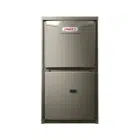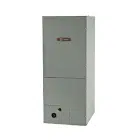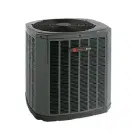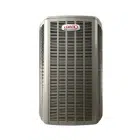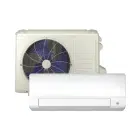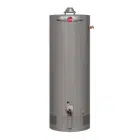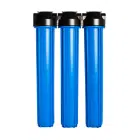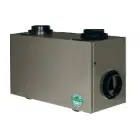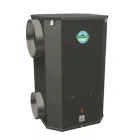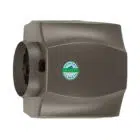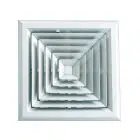
Table of Contents
Cooling a room without windows can seem impossible at first. No fresh air, no breeze, just stagnant heat hanging around and making things uncomfortable. But here’s the good news — you don’t need windows to stay cool. Whether it’s a basement, an interior office, or any space without natural ventilation, you can still maintain a comfortable temperature with a few smart, energy-efficient tricks. Let’s dive into five effective ways to cool a room without windows and keep things comfortable without running up your energy bill.
1. Portable Air Conditioners: Your Go-To Cooling Hero
The first thing that probably comes to mind when trying to cool a room is an air conditioner. But wait, we’re talking about a room without windows—how does that even work? This is where ventless air conditioners come in, and they’re a lifesaver. Unlike traditional window units that need, well, a window, portable AC units can be vented through doors, walls, or even a ceiling if that’s an option. They give you that same chill but with more flexibility.
A ventless air conditioner works by pulling in warm air from the room, cooling it down, and releasing it back into the space. This type of unit is particularly useful for a room without windows because it doesn’t rely on external airflow to operate efficiently. They can also be vented through an alternative space like a door or wall, making them an ideal option for spaces where installing a window unit isn’t possible.
Here’s the thing about portable air conditioners—they’re not all created equal. Some are way more efficient than others. When choosing a unit, you want to make sure you’re picking something energy-efficient so it cools the room without jacking up your electricity bill. Models with higher EER (Energy Efficiency Rating) will get you more bang for your buck, using less electricity to keep things cool.
A good portable air conditioner will work wonders, but it’s all about the setup. You’ve got to find a way to vent the hot air, and this is where a little creativity comes in. If you’ve got a door that leads outside, or even if you’re willing to cut a small vent in the wall (yes, this can be done professionally), you’re set. We’ve helped plenty of clients with these setups, and it’s not as complicated as it sounds. Plus, once it’s done, you’ve got cool air on tap anytime you need it.
2. Fans: Move That Air Around
Sometimes, the key to cooling isn’t about bringing in cold air but just getting the existing air to move around. Stagnant air traps heat, and that’s exactly what you’re trying to avoid in a room without windows. Fans can make a huge difference by keeping the air circulating, preventing it from sitting in one place and heating up.
The trick is knowing where to place the fans. A single fan won’t do much if it’s just pushing the same hot air around the room. You need to think strategically. Position a couple of fans so that they work together to create airflow—oscillating fans are great for this since they don’t just blow in one direction. Ceiling fans are also fantastic if you have the option to install one. They can push warm air up and out of the way, which is especially useful in the summer months when heat tends to rise.
A tower fan is another solid option, especially if space is an issue. These tall, slim units don’t take up much floor space, and many models come with features like timers and energy-saving modes that make them ideal for all-day use. We’ve seen some setups where people place a fan near a vent or door to draw cooler air from other parts of the house into the room. It’s all about getting creative with airflow.
In combination with a ventless air conditioner, fans help circulate the cooler air more evenly throughout the space, ensuring that every corner of your room stays comfortable. We’ve seen this combo work especially well in basement rooms or offices without windows, where airflow can be a major challenge.
3. Evaporative Coolers: A Simple, Budget-Friendly Solution

If you’ve never heard of an evaporative cooler, now’s the time to get familiar. These handy devices, sometimes called swamp coolers, are a solid alternative to traditional air conditioners in Canada. They work by adding moisture to the air and cooling it through evaporation—basically, the opposite of what a regular AC does.
Evaporative coolers are great in dry climates because they also add some humidity to the air. If you’re in a place where summers are hot and dry, this could be your new best friend. Plus, they’re generally more energy-efficient than air conditioners, which means you won’t see your electric bill skyrocket.
However, these coolers aren’t for everyone. If you live in a particularly humid area, you might find that adding moisture to the air isn’t all that helpful. But in a dry space, they can make a big difference. They’re also portable, so you can move them from room to room depending on where you need cooling the most. We often recommend evaporative coolers to our clients who want a low-cost, efficient cooling solution without the hassle of installation.
Pairing an evaporative cooler with a ductless air conditioner can create a powerful combination in a room without windows. While the evaporative cooler adds moisture and cools through evaporation, the ductless system can provide more consistent temperature control without needing ductwork, which is often difficult to install in smaller or windowless spaces.
4. Insulation: Keep the Heat Out
No matter how much cooling power you throw at a room, if heat is creeping in through the walls, ceiling, or door, it’s going to be a losing battle. That’s why insulation is so crucial, especially in a room without windows. Proper insulation keeps the heat outside where it belongs and helps maintain a stable indoor temperature. You’re not just cooling the room down; you’re making sure the cool air stays inside.
Start by focusing on the basics—check for any gaps or cracks around doors and walls. You’d be surprised how much heat can sneak in through even the tiniest spaces. Weather stripping around doors and windows (even if they don’t open) can seal up those gaps and prevent hot air from seeping in. It’s a simple, inexpensive fix that can make a big difference.
In more extreme cases, you might want to consider adding insulation to the walls or ceiling. This is especially important if the room is in a hot attic or next to an exterior wall that absorbs heat from the sun all day. Insulation doesn’t just keep rooms warm in the winter—it’s just as effective at keeping them cool in the summer. At HVAC Service Solutions, we’ve helped countless clients improve their insulation, and the results speak for themselves: lower energy bills, better temperature control, and a more comfortable living space.
5. Heat-Blocking Curtains: The Underrated Hero
You might not think about curtains when you’re trying to cool a room with no windows, but they’re actually a big deal—especially if your door has a glass pane or if your room borders a space with lots of natural light. Heat-blocking or blackout curtains can prevent heat from spilling into your room, even if it’s not direct sunlight.
Thermal curtains are designed to keep heat out, and they work particularly well on glass doors or any surfaces that conduct heat. Even if you don’t have windows, glass doors can act like a magnifying glass, focusing heat into your room. Adding a layer of heat-blocking fabric can reduce the temperature inside significantly.
If you don’t want to deal with the hassle of curtains, window film is another option. It’s applied directly to glass and can reflect heat away from the room. This might be a more subtle solution if you’re not a fan of heavy curtains but still want the benefits of blocking heat.
For rooms without windows, these small adjustments can make a huge difference, especially when combined with more active cooling methods like a ductless air conditioner. Ductless systems are great for spaces where installing traditional ductwork isn’t feasible. They offer a more flexible solution and can efficiently cool or heat your room depending on the season.
Final Thoughts: Let HVAC Service Solutions Keep You Cool
There’s no need to sweat it out just because your room doesn’t have windows. With the right tools and strategies, keeping your space cool is totally doable. Ventless air conditioners, fans, evaporative coolers, proper insulation, and even heat-blocking curtains can all work together to create a comfortable environment. And the best part? You don’t have to figure it out on your own.
At HVAC Service Solutions, we specialize in energy-efficient cooling solutions that can be tailored to your exact needs. Whether you’re looking for the perfect ventless air conditioner or need help installing insulation, our team of professionals is here to help. We’ve helped countless Canadians beat the heat in tricky spaces, and we’d love to help you do the same. Give us a call or reach out online for personalized recommendations and services that fit your space and your budget.
Stay cool out there, even if your room doesn’t have windows!
Frequent Asked Questions
How can I cool a room without windows?
Cooling a room without windows may seem tricky, but it’s entirely possible using a few smart strategies. You can start with a ventless air conditioner, which doesn’t rely on windows for venting, making it a great choice for enclosed spaces. Portable air conditioners and evaporative coolers are also effective at regulating the temperature. In addition to cooling units, consider installing fans to circulate the air and prevent stagnant heat from building up. Insulating the walls and doors will help keep unwanted heat out, while heat-blocking curtains on doors or any nearby glass surfaces can further reduce heat transfer. Combining these methods will ensure a comfortable temperature, even in rooms without windows.
What is a ventless air conditioner, and how does it work?
A ventless air conditioner is a cooling device that doesn’t require an external vent, unlike traditional air conditioners that need a window to expel warm air. These systems use air from within the room, cool it down, and recirculate it. Some models work by evaporating moisture to cool the air (similar to an evaporative cooler), while others use refrigerants. They are ideal for windowless rooms since they don’t need access to outside air, making them versatile for spaces like basements, attics, or interior offices. They are often portable, energy-efficient, and easy to move from room to room, making them a flexible option for cooling.
Can a ductless air conditioner cool a room without windows?
Yes, a ductless air conditioner is an excellent solution for cooling a room without windows. Unlike central air systems, ductless units don’t require extensive ductwork, which makes them ideal for spaces where installing ducts isn’t feasible. A ductless mini-split system can be mounted on the wall, and it works by cooling air directly in the room where the unit is installed. It’s highly efficient and can be used for both cooling and heating, depending on the model. The lack of windows isn’t an issue since the outdoor condenser unit is connected to the indoor air handler through a small hole in the wall, rather than relying on window access.
How do I insulate a room without windows to keep it cool?
Insulating a room without windows is key to keeping the space cool by preventing external heat from seeping in. Start by checking for any gaps around doors and walls—use weather stripping to seal them. Adding insulation to the walls or ceiling, especially if the room is adjacent to a hot area like an attic, can make a big difference in temperature regulation. Additionally, if there are glass doors or shared walls with rooms that get hot, consider installing thermal or blackout curtains to block heat. Proper insulation will keep the room cooler in the summer and warmer in the winter, making it energy-efficient year-round.
Are fans enough to cool a room without windows?
While fans alone may not significantly lower the temperature in a hot room without windows, they are incredibly effective at circulating air, which can make the space feel cooler. In combination with a cooling device like a ventless air conditioner or evaporative cooler, fans can help distribute the cooler air throughout the room, preventing hot spots and stuffiness. Placing multiple fans strategically, like an oscillating fan near the door or a ceiling fan, can maximize airflow. This combination is especially useful in small, enclosed spaces where natural airflow is limited.
Is a ventless air conditioner better than a ductless air conditioner for a room without windows?
It depends on your specific cooling needs and the room’s layout. A ventless air conditioner is ideal if you need a portable, flexible option that doesn’t require any major installation. It’s perfect for rooms where window venting isn’t possible, and it can be moved around as needed. On the other hand, a ductless air conditioner (mini-split system) offers a more permanent, powerful solution for long-term cooling. While it requires professional installation, it provides excellent, energy-efficient cooling without the need for ducts or windows. If you’re looking for a reliable, long-term solution, ductless is often the better choice.
What’s the best way to circulate air in a room without windows?
The best way to circulate air in a room without windows is to strategically place multiple fans throughout the space. Oscillating fans can move air around the room effectively, preventing heat from settling in one area. A ceiling fan, if installed, can also help by pushing warm air up and away, while a floor fan or tower fan can pull cooler air in from adjacent spaces like hallways. If you’re using a ventless air conditioner or evaporative cooler, a fan can help distribute the cooler air evenly across the room. Placing a fan near a doorway to draw in cooler air from the rest of the house can further improve circulation.
Can an evaporative cooler work in a humid environment?
Evaporative coolers are generally less effective in humid environments because they rely on the process of evaporating water to cool the air. When the air is already full of moisture, evaporation happens much more slowly, meaning the cooler can’t do its job as effectively. In these conditions, a ventless air conditioner or ductless air conditioner would likely provide better cooling results. Evaporative coolers are best suited for dry, arid climates where adding moisture to the air helps both cool the room and improve comfort levels.
Can blackout curtains really help cool a room without windows?
Yes, blackout curtains or thermal curtains can make a noticeable difference in a room without windows, particularly if the room has a glass door or shared walls with spaces that get a lot of sun. These curtains are designed to block out heat and sunlight, which can help prevent the room from heating up during the day. Even if your room doesn’t have direct access to sunlight, these curtains can still help by insulating the space and preventing heat from radiating through walls and doors. Pairing blackout curtains with a ventless air conditioner or a ductless air conditioner can create an even more effective cooling environment.
Share

